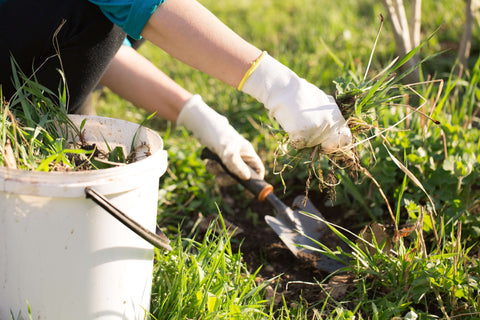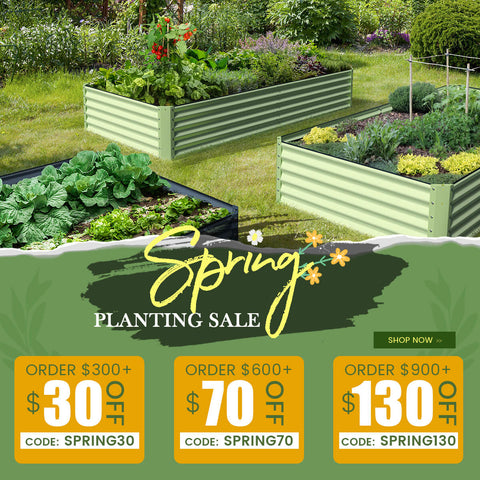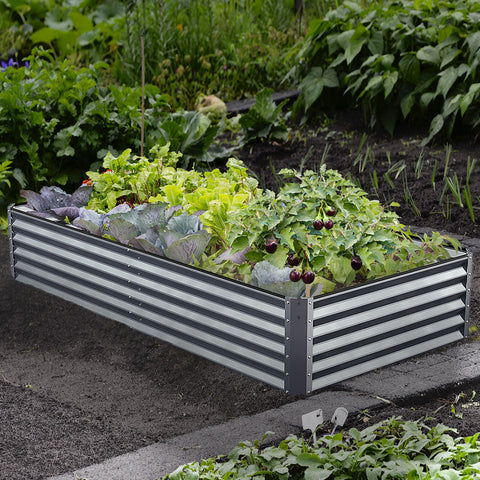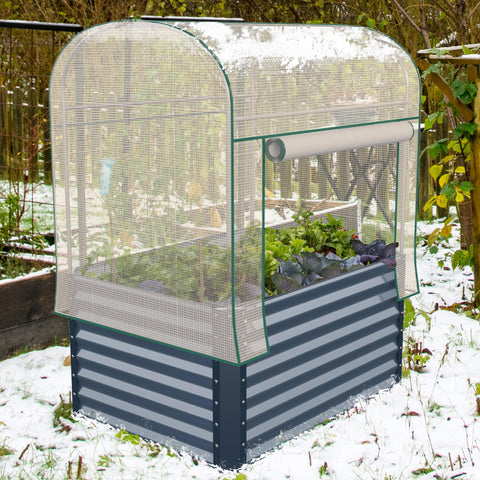Want metal flower beds, but not sure if they're too hot? Depending on the type of bed you use, a metal bed can be a good choice. In this article, Taylor Sievers, gardening expert and owner of Cut Flower Farms, explores the science behind using metal in creating flower beds.The following content also has some reference value for raised garden beds.
Are you eager to try loft bed gardening, but worried that it might be too hot?
This is a common problem, and to be honest, it was something I worried about myself when we decided to build raised beds near our house.

Don't worry! Raised beds are naturally warmer because they are exposed to more sunlight than the soil underneath. However, raised flower beds won't get your plants too hot.
Read on to learn more about raised bed gardening, including my raised bed gardening tips for success!
The advantages of keeping a bed
For small or paved backyards, high weed pressure, wet soil and limited mobility, raised beds are a good choice.

If you:
- Have a small backyard (or mostly paved backyard)
- High weed pressure
- The soil is naturally moist
- Difficulty bending or kneeling
- Want a nice garden
Raised bed gardening has many benefits, such as increased drainage and faster soil warming in the spring. You'll also spend less time dealing with dreaded garden weeds.
Some elevated beds are built to raise them. I've seen some hip-high and higher. Birdie metal garden beds come in a variety of sizes, including a 30 "tall bed. The elevated garden space is a blessing for those of us with back pain!
The raised bed is not only functional, but also very beautiful. Plants grow inside their beds in neat little circles, squares, or rectangles. For someone who likes a neat garden, a raised bed might be right for you!
Is the raised metal bed too hot?
When I decided to install a metal bed near my home, my first question was: Would my metal bed get too hot?
The short answer is: No.
While I don't live in the Deep South, where temperatures soar, I do live in the Midwest, where summer temperatures can easily top 100 degrees Fahrenheit.
I have toddlers, and I know that these beds are next to the house, and the kids may touch the edges of the beds, whether it's digging or pulling carrots.
On my farm, I have three different types of raised beds: wood, cinder blocks, and metal.

While wood raised beds aren't as warm as cinder block or metal beds, I don't have any problems with my metal beds and actually prefer them.
The only thing I noticed was that the outer edge of the bed was probably slightly warmer than the soil inside the bed. But the best part is, soil has a tremendous capacity to absorb heat, and my plants do it very well. In fact, they thrive.
In hot weather, the sides of the metal will feel warm. But it's no different than my cinder block bed. Our metal bed never burned me or the children.
The secret to successfully raising the bed
If you want to get into bed gardening, there are a few things you need to consider. It's important to choose the right plants, use the right soil, and water your bed properly.
Tip # 1: Choose the right plants
So, we know that a raised bed is raised. This increases drainage. Because they're exposed to more sunlight, it also warms them up faster.
This means that if you live in a warm climate, you need to choose plants that thrive in a warm, well-drained environment.
A plant that loves heat and sunshine
You need to choose plants that love heat. Summer flowering plants such as zinnias, cockscrowns, dahlias, large lanterns, periwinks, marigolds, sweet potato vines, geranium and canna lilies are great choices for landscaping.
If you are looking for vegetables or herbs to add to your cultivated bed, try growing tomatoes, peppers, lavender, thyme, oregano, basil, and more.
Think of raised beds as giant containers or patio planters. If you plant it in a sunny pot, then you are likely to grow it successfully on a raised bed.
Root crop
Root crops thrive on raised beds because the soil is usually loose and fertile.
In the past, I struggled to grow carrots and potatoes on thick clay. But by growing root crops like potatoes, sweet potatoes, carrots, turnips, radishes, and beets in raised soil, you don't have to worry about sticky soil compressing roots into strange shapes or limiting growth entirely.
I will never eat forkful carrots and baby potatoes again!
Plants that need good drainage

Some plants do not like to water the soil. As a cut flower grower, I've seen dahlias, anemones, buttercups and tulips rot in my soil. It's disappointing when those expensive bulbs, tubers and corms wither.
Planting flowers grown from tubers or bulbs on raised beds is a good way to reduce rot losses because they drain well.
Cool season plant
Other good bedding plants are cold-season flowers and vegetables, which may need to be sown in early spring.
As mentioned earlier, raised beds are elevated, so soil temperatures are naturally higher than ground temperatures due to more exposure to sunlight.
If you plant cool season crops such as broccoli, lettuce, spinach, edible mustard, Brussels sprouts, etc., you can harvest as early as late winter. If you want to plant an autumn garden, you can also harvest greens in the winter.
Some people have even managed to grow beds all winter by adding frosting cloths to them. Hello, home spinach for Christmas!
Tip # 2: Choose the right soil
There are many ideas about what type of soil to use for a bed.
I'll be the first to admit that when I made my first raised bed, all I did was use a plain potting mix (no fertilizer added) mixed with coconut coconut. And the result? My plants grew, but they were boring, to say the least.
You see, peat and coconut there's not a lot of fertility or nutrition in the coconut itself. That's why when you buy a bag of potting mix at the store, fertilizer is usually added.
After that, I changed my course. We buy compost in bulk from a local supplier and fill all our raised beds with compost. Since we switched, our plants have been thriving! Now we also use some of our own composted chicken manure.
Compost is made from decomposing plants and living organisms and is naturally used as a soil conditioner. Make sure you get your compost from a reputable source, though.
The main thing is that you want your compost to "finish" decomposing. This means that compost won't burn your plants, and you won't have a billion weed seedlings popping up (some weeds are normal; Remember, compost is not sterile).

Some people like to mix in a little dirt of their own, at least under the bed. Soil naturally contains nutrients that are important for plant growth.
If you want to buy pre-mixed soil for your garden bed and save some research, there are also many options available for purchase.
There are other modifications you can make to your raised bed. You can add chopped leaves, grass clippings, straw and even a bit of peat and coconut. There is no one right way to fill your raised bed.
Most importantly, don't just use regular soil from your yard for planting. Oh! You may have a weed mess. Also, because you break up the soil structure when you dig, it's likely to settle into hard, dense clods. I've seen this before, and it's not pretty.
If you have a tall elevated bed, such as the Birdies tall 6 in 1 metal elevated garden bed (30 inches tall), you may need to use filler on the bottom so you don't have to use as much elevated garden bed soil. Caulk can include logs, unfinished compost, your natural garden soil, leaves, grass clippings, etc., at the bottom.
Tip 3: Water as needed
Just like your patio POTS, you must water your nursery, not your regular ground garden.
Raised bed soil naturally increases drainage and warmth, so don't forget to check the humidity of your bed, especially in areas that are dry in the summer.
I like to sprinkle water on my bed because it is near my home. They're also not too big, so they're easy to water by hand.
But if you have large raised beds, or you want to simplify your life, you can use different forms of irrigation, such as soaking hoses and drip irrigation belts to water your plants. Simply install your system and turn on the water. You can even set a fully automated timer!
Tip # 4: Why is a raised metal bed best
In this article, we discuss the benefits of raised beds, such as increased drainage, reduced bending and reach for planting and harvesting, reduced weed stress, and more.
As I mentioned above, there are many materials you can use to make raised beds.
But of the three materials I've used - cinder blocks, wood and metal - a metal bed is the best choice for our home.
Here's why metal loft beds are so great:
Rot resistance
Softwoods like pine are the cheapest option and probably the most readily available. But wood breaks down and bends easily over time, even if it's a more rot resistant wood like cedar or hemlock. Metal beds are a more durable option because they don't rot or warp
Final thought

Raised garden beds provide good drainage, less weed pressure, and soil warms faster in cooler temperatures. They also take pressure off the back and knees and are aesthetically pleasing.
One of the big questions about elevated flower beds is: Are they too hot? Luckily, if you're using metal flowerbeds (like Birdies), then your flowerbeds won't get too hot. In fact, many garden plants will not only grow, but thrive in a raised bed environment.
Choosing the right plants and soil while providing enough water is the key to successful cultivated flower bed growth. Making use of a raised garden bed in your backyard could be one of the best decisions you make. At least for me!









